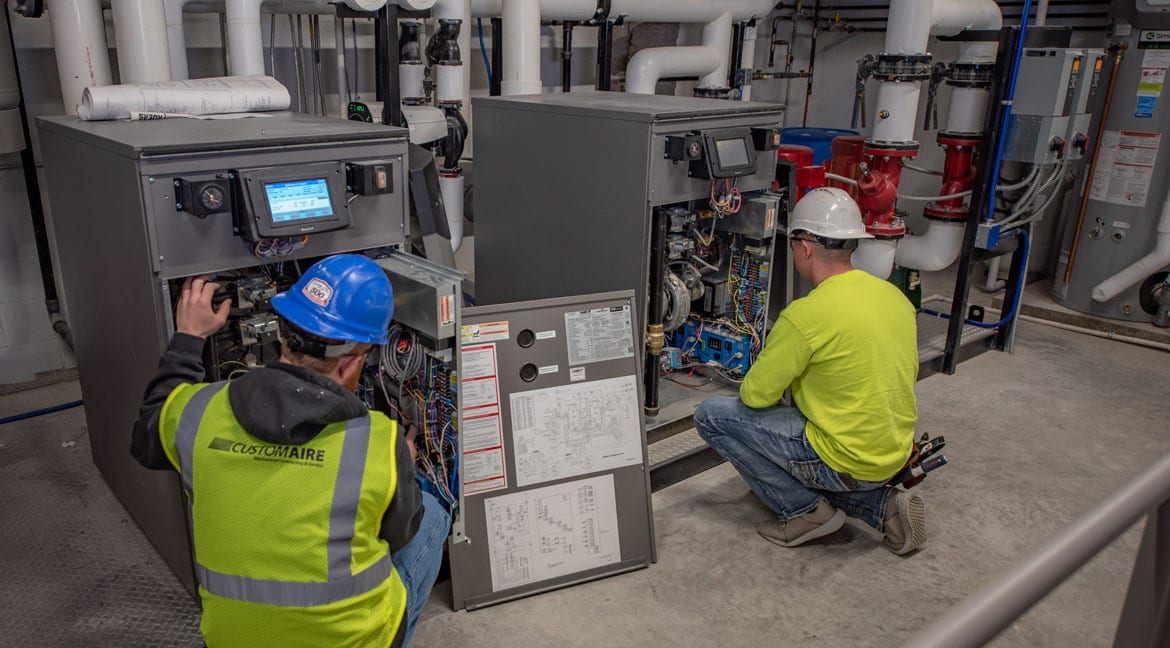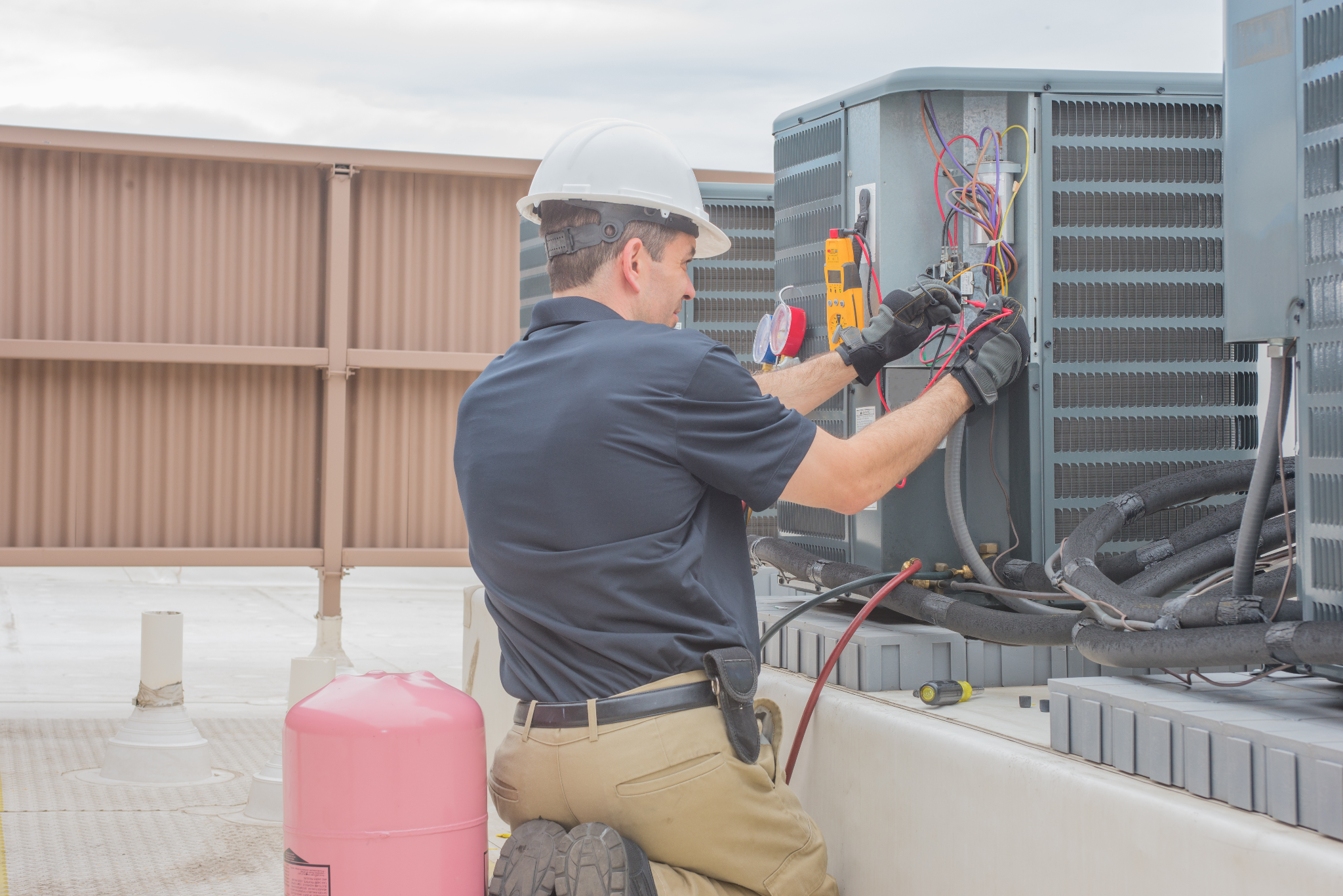Is a furnace replacement Worth It?
Is a furnace replacement Worth It?
Blog Article
Just How a Warmth Pump and Heater Interact to Maximize Your Home's Heating Performance
Understanding just how a warmth pump and furnace interact is necessary for homeowners seeking effective home heating services. Each system has its strengths, providing a well balanced approach to home convenience. The heat pump masters modest temperature levels, while the heating system delivers quick heat throughout extreme cold. This synergy not only reduces energy prices yet also boosts the life expectancy of both home appliances. What factors affect this cooperation, and how can homeowners optimize their advantages?
Comprehending Warm Pumps: Just How They Work
Numerous people may be strange with their internal functions, heat pumps play an important duty in modern-day home heating systems. These devices operate by transferring warm from one location to an additional, using the principles of thermodynamics. In chillier months, a heat pump removes warm from the outdoors air, ground, or water, and transfers it indoors to warm up the space. Alternatively, throughout warmer months, it can reverse the procedure, acting as an air conditioner by expelling warmth from inside to the outside.Heat pumps contain an evaporator, condenser, compressor, and development valve. The cooling agent within the system soaks up warm as it vaporizes at low temperature levels and pressures. The compressor after that enhances the stress and temperature level of the cooling agent, permitting it to release warm as it condenses. This reliable process can substantially reduce power consumption contrasted to typical home heating techniques, making heat pumps a sustainable option for climate control in homes.
The Role of Furnaces in Home Heating
Heaters play an essential duty in home heating by providing a trusted resource of warmth throughout the chillier months. They run by creating heat through combustion or electrical resistance, distributing it throughout the home through air ducts or radiant systems. The efficiency of a heater is typically measured by its Yearly Fuel Usage Performance (AFUE) score, which shows just how effectively the unit transforms fuel right into heat.Furnaces can utilize various energy sources, consisting of gas, oil, electricity, or propane, permitting property owners to choose one of the most appropriate option for their requirements. Unlike heatpump, which might battle in severe cold, heaters maintain regular performance, guaranteeing that indoor temperatures stay comfy no matter outdoor conditions. Additionally, modern heaters typically come furnished with sophisticated innovation, such as variable-speed blowers and wise thermostats, improving their effectiveness and responsiveness. This versatility makes furnaces an important part in all-inclusive home heating approaches.

Advantages of Using Both Equipments With Each Other
Integrating the toughness of both heaters and warmth pumps can bring about a much more reliable and reliable home heating remedy. Making use of both systems permits home owners to benefit from the heatpump's energy effectiveness during milder temperatures while depending on the furnace for more severe cold conditions. This double approach can significantly minimize energy expenses, as heatpump take in much less power than typical heating methods when temperature levels are moderate.Additionally, using both systems together can improve convenience levels in the home. Heatpump can offer regular, even heating, while heaters can promptly raise ambient temperature levels when required. The combination of both systems can prolong the life-span of tools by decreasing wear and tear on each device, as they share the work. Eventually, house owners can delight in a balanced, cost-efficient heating solution that adjusts perfectly to differing climate condition, making sure a warm and welcoming home throughout the winter season.
Exactly How Warm Pumps and Furnaces Complement Each Other
When home owners integrate heat pumps and furnaces, they create a complementary heater that maximizes efficiency and convenience. Heatpump run by moving heat from the outside air or ground, making them extremely effective in modest climates. They stand out during milder temperature levels, offering affordable home heating. Alternatively, furnaces generate warm with burning or electric resistance, supplying solid, prompt heat throughout severe cool conditions.The mix of these 2 systems enables dynamic modifications based on temperature variations. Throughout warmer months or milder winter season days, the heatpump can take the lead, conserving power and minimizing expenses. As temperature levels decrease, the heater can perfectly engage, ensuring constant warmth throughout the home. This harmony not just optimizes energy usage but additionally enhances the lifespan of both systems, as each unit runs within its ideal efficiency range. With each other, they produce a balanced setting that adjusts to varying environment demands.
Enhancing Effectiveness: Tips for Homeowners
Homeowners can enhance their home heating performance via several sensible techniques. Establishing a normal upkeep schedule, incorporating smart thermostat technology, and applying effective insulation and securing remedies are crucial actions. These procedures not only improve comfort but also lower power expenses.
Routine Maintenance Arrange
To ensure maximum heating effectiveness, establishing a normal maintenance schedule is important for any kind of home. Homeowners should focus on regular assessments of both heatpump and furnaces to determine peak efficiency. This includes transforming air filters every one to 3 months, as clogged filters can significantly minimize his response effectiveness. Additionally, scheduling professional upkeep at the very least yearly allows specialists to recognize and resolve possible problems prior to they intensify. Property owners should also cleanse the warmth pump's exterior device to stop particles accumulation that can hinder airflow. By sticking to a normal upkeep timetable, homeowners not just enhance their heating unit' effectiveness however likewise extend their life-span, bring about higher convenience and decreased power expenses throughout the colder months.
Smart Thermostat Integration
Integrating a smart thermostat right into a home heating system can greatly boost energy performance, specifically as it permits precise control over temperature setups. These devices can learn the homeowner's routine and choices, immediately adjusting the temperature level to maximize convenience while minimizing energy use. For circumstances, they can lower heating throughout times when the home is vacant, reducing unneeded consumption. Many clever thermostats additionally give real-time energy usage data, allowing homeowners to make informed decisions regarding their heating behaviors. Additionally, remote gain access to using mobile phone apps permits customers to readjust setups from anywhere, ensuring the home is cozy upon return. On the whole, smart thermostat assimilation not just improves comfort however significantly adds to energy savings and performance.
Insulation and Sealing Solutions
Smart thermostats play a crucial role in energy effectiveness, but their performance can be greatly enhanced by appropriate insulation and sealing options. Property owners should prioritize insulating floors, attics, and walls to lessen warmth loss. Premium insulation materials, such as spray foam or fiberglass, can substantially boost thermal resistance. Additionally, sealing gaps around windows, doors, and air ducts prevents cold air seepage and warm escape. Weatherstripping and caulking are effective methods for attending to these leaks - heat pump service. Routine inspections for air leakages, together with the usage of blower door tests, can aid determine issue locations. By spending in insulation and sealing, property owners can enhance the performance of their heating systems, eventually causing decreased energy intake and lower energy bills
Common Misconceptions Concerning Warm Pumps and Furnaces
What false impressions surround warmth pumps and furnaces? Many people incorrectly believe that warmth pumps are inefficient in chillier climates. In truth, modern-day heatpump are made to run successfully even in reduced temperatures, offering reputable home heating throughout wintertime. Another typical myth is that heaters are always a lot more efficient than warmth pumps. This depends on the certain power resources and efficiency rankings of the systems in concern. Some might also think that making use of both systems simultaneously is unnecessary, however in truth, this combination can optimize heating performance, especially during extreme climate condition. Additionally, people often assume that heatpump require consistent upkeep, when in reality, they have similar upkeep needs to traditional heating unit. By unmasking these misconceptions, property owners can make more educated choices regarding their heating options, eventually causing improved convenience and power efficiency in their homes.
Upkeep Factors To Consider for Combined Systems

Often Asked Questions
Can Heat Pumps Work Efficiently in Extremely Cold Climates?
Heatpump can have a hard time in very cool climates because of minimized efficiency and heat removal limitations. Nonetheless, improvements in modern technology have actually caused designs developed for much better performance in such problems, boosting their practicality in extreme settings.
For How Long Do Heat Pumps and Furnaces Usually Last?
Heatpump generally last 15 to twenty years, while heaters have a life expectancy of 15 to three decades. Routine maintenance can expand their durability, making sure efficient operation and minimizing the requirement for premature substitutes.

What Is the Typical Expense of Installing Both Systems?
The typical cost of mounting both a warm pump and a heater generally varies between $5,000 to $10,000 - heat pump installation ooltewah tn. Variables influencing this price include system dimension, installation complexity, and local labor prices
Are There Tax Obligation Motivations for Using Energy-Efficient Home Heating Equipments?
Numerous home owners ask concerning tax rewards for energy-efficient furnace. Various federal and state programs often supply rebates or credit reports, motivating the fostering of sustainable technologies to minimize energy consumption and promote environmental responsibility.
Just how Do I Pick the Right Size Heatpump and Heater?
Selecting the ideal size heatpump and heating system includes computing the home's square video, considering insulation top quality, and evaluating local environment. Consulting a specialist can assure suitable system efficiency and power performance based upon particular requirements. heat pump replacement ooltewah tn. Comprehending exactly how a warmth pump and heating system work with each other is essential for homeowners seeking reliable home heating options. In chillier go to my site months, a warm pump essences heat from the outdoors air, ground, or water, and transfers it indoors to heat the living area. When property owners incorporate warmth pumps and heaters, they create a complementary heating system that maximizes performance and comfort. Warm pumps run by transferring warmth from the outside air or ground, making them extremely reliable in modest climates. Heat pumps can have a hard time in very cool environments due to minimized effectiveness and heat removal limitations
Report this page